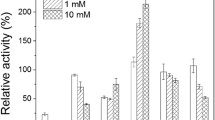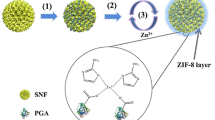Abstract
To improve the catalysis of pullulanase from Anoxybacillus sp.WB42, Fe3O4@polydopamine nanoparticles (Fe3O4@PDA) were prepared and modified with functional groups for immobilization of pullulanases via covalent binding or ionic adsorption. Immobilized pullulanases had lower thermal stability than that of free pullulanase, whereas their catalysis depended on the surface characteristics of nanoparticles. As for covalent immobilization of pullulanases onto Fe3O4@PDA derivatives, the spacer grafted onto Fe3O4@PDA made the catalytic efficiency of pullulanase increase up to the equivalence of free enzyme but dramatically reduced the pullulanase thermostability. In contrast, pullulanases bounded ionically to Fe3O4@PDA derivatives had higher activity recovery and catalytic efficiency, and their catalytic behaviors varied with the modifier grafted onto Fe3O4@PDA. Among these immobilized pullulanases, ionic adsorption of pullulanase on Fe3O4@PDA-polyethyleneimine-glycidyltrimethylammonium gave a high-performance and durable catalyst, which displayed not only 1.5-fold increase in catalytic efficiency compared to free enzyme but also a significant improvement in operation stability with a half of initial activity after 27 consecutive cycles with a total reaction time of 13.5 h, and was reversible, making this nanoparticle reusable for immobilization.


Similar content being viewed by others
References
Hii, S. L., Tan, J. S., Ling, T. C., & Ariff, A. B. (2012). Pullulanase: role in starch hydrolysis and potential industrial applications. Enzyme Research, 2012, 921362. doi:10.1155/2012/921362.
Singh, R. S., Saini, G. K., & Kennedy, J. F. (2010). Maltotriose syrup preparation from pullulan using pullulanase. Carbohydrate Polymers, 80, 401–407.
Singh, R. S., Saini, G. K., & Kennedy, J. F. (2011). Continuous hydrolysis of pullulan using covalently immobilized pullulanase in a packed bed reactor. Carbohydrate Polymers, 83, 672–675.
Ansari, S. A., & Husain, Q. (2012). Potential applications of enzymes immobilized on/in nano materials: a review. Biotechnology Advances, 30, 512–523.
Talekar, S., Desai, S., Pillai, M., Nagavekar, N., Ambarkar, S., Surnis, S., Ladole, M., Nadara, S., & Mulla, M. (2013). Carrier free co-immobilization of glucoamylase and pullulanase as combi-cross linked enzyme aggregates (combi-CLEAs). RSC Advances, 3, 2265–2271.
Ali, G., Dulong, V., Gasmi, S. N., Rihouey, C., Picton, L., & Le Cerf, D. (2015). Covalent immobilization of pullulanase on alginate and study of its hydrolysis of pullulan. Biotechnology Progress, 31, 883–889.
Kuroiwa, T., Shoda, H., Ichikawa, S., Sato, S., & Mukataka, S. (2005). Immobilization and stabilization of pullulanase from Klebsiella pneumoniae by a multipoint attachment method using activated agar gel supports. Process Biochemistry, 40, 2637–2642.
Dessouki, A. M., Issa, G. I., & Atia, K. S. (2001). Pullulanase immobilization on natural and synthetic polymers. Journal of Chemical Technology and Biotechnology, 76, 700–706.
George, R., & Sugunan, S. (2014). Kinetic and thermodynamic parameters of immobilized glucoamylase on different mesoporous silica for starch hydrolysis: a comparative study. Journal of Molecular Catalysis B: Enzymatic, 106, 81–89.
Zhang, L., Zhu, X., Zheng, S., & Sun, H. (2009). Photochemical preparation of magnetic chitosan beads for immobilization of pullulanase. Biochemical Engineering Journal, 46, 83–87.
Long, J., Jiao, A., Wei, B., Wu, Z., Zhang, Y., Xu, X., & Jin, Z. (2014). A novel method for pullulanase immobilized onto magnetic chitosan/Fe3O4 composite nanoparticles by in situ preparation and evaluation of the enzyme stability. Journal of Molecular Catalysis B: Enzymatic, 109, 53–61.
Long, J., Li, X., Wu, Z., Xu, E., Xu, X., Jin, Z., & Jiao, A. (2015). Immobilization of pullulanase onto activated magnetic chitosan/ Fe3O4 nanoparticles prepared by in situ mineralization and effect of surface functional groups on the stability. Colloids and Surfaces A: Physicochemical and Engineering, 472, 69–77.
Long, J., Xu, E., Li, X., Wu, Z., Wang, F., Xu, X., Jin, Z., Jiao, A., & Zhan, X. (2016). Effect of chitosan molecular weight on the formation of chitosan–pullulanase soluble complexes and their application in the immobilization of pullulanase onto Fe3O4–κ-carrageenan nanoparticles. Food Chemistry, 202, 49–58.
Kusano, S., Shiraishi, T., Takahashi, S. I., Fujimoto, D., & Sakano, Y. (1989). Immobilization of Bacillus acidopullulyticus pullulanase and properties of the immobilized pullulanases. Journal of Fermentation and Bioengineering, 68, 233–237.
Živković, L. T. I., Živković, L. S., Babić, B. M., Kokunešoski, M. J., Jokić, B. M., & Karadžić, I. M. (2015). Immobilization of Candida rugosa lipase by adsorption onto biosafe meso/macroporous silica and zirconia. Biochemical Engineering Journal, 93, 73–83.
Cesar, M., Fernandez-Lafuente, R., & Guisan, J. M. (2000). Reversible enzyme immobilization via a very strong and nondistorting ionic adsorption on support polyethyleneimine composites. Biotechnology and Bioengineering, 68, 98–105.
Torres, R., Pessela, B. C., Mateo, C., Ortiz, C., Fuentes, M., Guisan, J. M., & Fernandez-afuente, R. (2004). Reversible immobilization of glucoamylase by ionic adsorption on sepabeads coated with polyethyleneimine. Biotechnology Progress, 20, 1297–1300.
Fuentes, M., Pessela, B. C., Maquiese, J. V., Ortiz, C., Segura, R. L., Palomo, J. M., & Guisán, J. M. (2004). Reversible and strong immobilization of proteins by ionic exchange on supports coated with sulfate-dextran. Biotechnology Progress, 20, 1134–1139.
Khoobi, M., Motevalizadeh, S. F., Asadgol, Z., Forootanfar, H., Shafiee, A., & Faramarzi, M. A. (2015). Polyethyleneimine-modified superparamagnetic Fe3O4 nanoparticles for lipase immobilization: characterization and application. Materials Chemistry and Physics, 149, 77–86.
Wang, J., Zhao, G., Li, Y., Peng, X., & Wang, X. (2015). Preparation of amine-functionalized mesoporous magnetic colloidal nanocrystal clusters for glucoamylase immobilization. Chemical Engineering Journal, 263, 471–478.
Zhang, Y., Ge, J., & Liu, Z. (2015). Enhanced activity of immobilized or chemically modified enzymes. ACS Catalysis, 5, 4503–4513.
Pavlidis, I. V., Vorhaben, T., Gournis, D., Papadopoulos, G. K., Bornscheuer, U. T., & Stamatis, H. (2012). Regulation of catalytic behaviour of hydrolases through interactions with functionalized carbon-based nanomaterials. Journal of Nanoparticle Research, 14, 1–10.
Ding, S., Cargill, A. A., Medintz, I. L., & Claussen, J. C. (2015). Increasing the activity of immobilized enzymes with nanoparticle conjugation. Current Opinion in Biotechnology, 34, 242–250.
Johnson, B. J., Algar, W. R., Malanoski, A. P., Ancona, M. G., & Medintz, I. L. (2014). Understanding enzymatic acceleration at nanoparticle interfaces: approaches and challenges. Nano Today, 9, 102–131.
Liu, R., Guo, Y., Odusote, G., Qu, F., & Priestley, R. D. (2013). Core–shell Fe3O4 polydopamine nanoparticles serve multipurpose as drug carrier, catalyst support and carbon adsorbent. ACS Applied Materials & Interfaces, 5, 9167–9171.
Mo, R. Y., & Wang, G. Z. (2008). Preparation of supermagnetic dextran-coated iron oxide nanoparticles and using for h-22 cells magnetic labeling. Acta Biochimica et Biophysica Sinica, 6, 009.
Chang, P. R., Yu, J., Ma, X., & Anderson, D. P. (2011). Polysaccharides as stabilizers for the synthesis of magnetic nanoparticles. Carbohydrate Polymers, 83, 640–644.
Lee, H., Dellatore, S. M., Miller, W. M., & Messersmith, P. B. (2007). Mussel-inspired surface chemistry for multifunctional coatings. Science, 318, 426–430.
Bailey, M. J. (1988). A note on the use of dinitrosalicylic acid for determining the products of enzymatic reactions. Applied Microbiology and Biotechnology, 29, 494–496.
Tang, Q. Y., & Zhang, C. X. (2013). Data Processing System (DPS) software with experimental design, statistical analysis and data mining developed for use in entomological research. Insect Science, 20, 254–260.
Lee, H., Rho, J., & Messersmith, P. B. (2009). Facile conjugation of biomolecules onto surfaces via mussel adhesive protein inspired coatings. Advanced Materials, 21, 431–434.
Talbert, J. N., & Goddard, J. M. (2012). Enzymes on material surfaces. Colloids and Surfaces B: Biointerfaces, 93, 8–19.
Kuan, I., Liao, R., Hsieh, H., Chen, K., & Yu, C. (2008). Properties of D-amino acid oxidase immobilized on magnetic beads through His-tag. Journal of Bioscience and Bioengineering, 105, 110–115.
Barbosa, O., Torres, R., Ortiz, C., Berenguer-Murcia, A., Rodrigues, R. C., & Fernandez-Lafuente, R. (2013). Heterofunctional supports in enzyme immobilization: from traditional immobilization protocols to opportunities in tuning enzyme properties. Biomacromolecules, 14, 2433–2462.
Aissaoui, N., Landoulsi, J., Bergaoui, L., Boujday, S., & Lambert, J. F. (2013). Catalytic activity and thermostability of enzymes immobilized on silanized surface: influence of the crosslinking agent. Enzyme and Microbial Technology, 52, 336–343.
Hernandez, K., & Fernandez-Lafuente, R. (2011). Control of protein immobilization: coupling immobilization and site-directed mutagenesis to improve biocatalyst or biosensor performance. Enzyme and Microbial Technology, 48, 107–122.
Goldstein, L., Levin, Y., & Katchalski, E. (1964). A water-insoluble polyanionic derivative of trypsin. II. effect of the polyelectrolyte carrier on the kinetic behavior of the bound Trypsin. Biochemistry, 3, 1913–1919.
Goldstein, L., Pecht, M., Blumberg, S., Atlas, D., & Levin, Y. (1970). Water-insoluble enzymes. Synthesis of a new carrier and its utilization for preparation of insoluble derivatives of papain, trypsin, and subtilopeptidase A. Biochemistry, 9, 2322–2334.
Goldstein, L. (1972). Microenvironmental effects on enzyme catalysis. Kinetic study of polyanionic and polycationic derivatives of chymotrypsin. Biochemistry, 11, 4072–4084.
Vahidi, A. K., Yang, Y., Ngo, T. P., & Li, Z. (2015). Simple and efficient immobilization of extra-cellular his-tagged enzyme directly from cell culture supernatant as active and recyclable nanobiocatalyst: high performance production of biodiesel from waste grease. ACS Catalysis, 5, 3157–3161.
Cha, T., Guo, A., & Zhu, X. Y. (2005). Enzymatic activity on a chip: the critical role of protein orientation. Proteomics, 5, 416–419.
Singh, R. S., Saini, G. K., & Kennedy, J. F. (2010). Covalent immobilization and thermodynamic characterization of pullulanase for the hydrolysis of pullulan in batch system. Carbohydrate Polymers, 81, 252–259.
Campbell, A. S., Dong, C., Meng, F., Hardinger, J., Perhinschi, G., Wu, N., & Dinu, C. Z. (2014). Enzyme catalytic efficiency: a function of bio–nano interface reactions. ACS Applied Materials & Interfaces, 6, 5393–5403.
Author information
Authors and Affiliations
Corresponding author
Ethics declarations
Conflict of Interest
The authors declare that they have no conflict of interest.
Ethical Approval
This article does not contain any studies with human participants or animals performed by any of the authors.
Funding
This research did not receive any specific grant from funding agencies in the public, commercial, or nonprofit sectors.
Electronic supplementary material
ESM 1
(DOCX 131 kb)
Rights and permissions
About this article
Cite this article
Wang, J., Liu, Z. & Zhou, Z. Improving Pullulanase Catalysis via Reversible Immobilization on Modified Fe3O4@Polydopamine Nanoparticles. Appl Biochem Biotechnol 182, 1467–1477 (2017). https://doi.org/10.1007/s12010-017-2411-x
Received:
Accepted:
Published:
Issue Date:
DOI: https://doi.org/10.1007/s12010-017-2411-x




